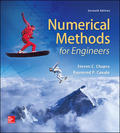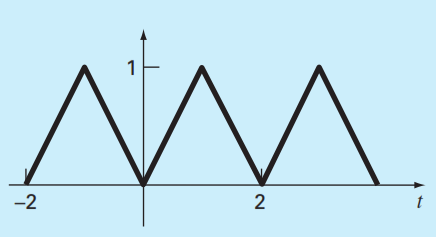
EBK NUMERICAL METHODS FOR ENGINEERS
7th Edition
ISBN: 8220100254147
Author: Chapra
Publisher: MCG
expand_more
expand_more
format_list_bulleted
Textbook Question
Chapter 19, Problem 5P
Use a continuous Fourier series to approximate the wave form in Fig. P19.5. Plot the first three terms along with the summation.
FIGURE P19.5
A triangular wave.

Expert Solution & Answer
Want to see the full answer?
Check out a sample textbook solution
Students have asked these similar questions
1
S
0
sin(lnx)
x² - 1
Inx
dx
2
6. Modelling. Suppose that we have two tanks (A and B) between which a mixture of brine
flows. Tank A contains 200 liters of water in which 50 kilograms of salt has been dissolved
and Tank B contains 100 liters of pure water. Water containing 1kg of salt per liter is
pumped into Tank A at the rate of 5 liters per minute. Brine mixture is pumped into
Tank A from Tank B at the rate of 3 liters per minute and brine mixture is pumped from
Tank A into Tank B at the rate of 8 liters per minute. Brine is drained from Tank B at a
rate of 5 liters per minute.
(a) Draw and carefully label a picture of the situation, including both tanks and the flow
of brine between them.
JankA
1ks of
Salt
Slits
Pump
EL
Brine mit
tark A from tank 13
Tank 13
k
3L
zooliters of
Ico liters of
water with
pure water.
Saky salt
→
777
disslore inside
Brine mix is pumped from
tank A to B of 82
Brine drainen
min
by Gf salt (b) Assume all brine mixtures are well-stirred. If we let t be the time in minutes, let x(t)
1ks…
No chatgpt pls
Chapter 19 Solutions
EBK NUMERICAL METHODS FOR ENGINEERS
Ch. 19 - The average values of a function can be determined...Ch. 19 - The solar radiation for Tucson, Arizona, has been...Ch. 19 - 19.3 The pH in a reactor varies sinusoidally over...Ch. 19 - 19.4 Use a continuous Fourier series to...Ch. 19 - 19.5 Use a continuous Fourier series to...Ch. 19 - Construct amplitude and phase line spectra for...Ch. 19 - 19.7 Construct amplitude and phase line spectra...Ch. 19 - 19.8 A half-wave rectifier can be characterized...Ch. 19 - 19.9 Construct amplitude and phase line spectra...Ch. 19 - Develop a user-friendly program for the DFT based...
Ch. 19 - 19.11 Use the program from Prob. 19.10 to compute...Ch. 19 - 19.12 Develop a user-friendly program for the FFT...Ch. 19 - 19.13 Repeat Prob. 19.11 using the software you...Ch. 19 - An object is suspended in a wind tunnel and the...Ch. 19 - 19.15 Use the Excel Data Analysis ToolPak to...Ch. 19 - Use the Excel Data Analysis Toolpack to fit a...Ch. 19 - (a) Use MATLAB to fit a cubic spline to the...Ch. 19 - 19.18 Use MATLAB to generate 64 points from the...Ch. 19 - In a fashion similar to Sec. 19.8.2, use MATLAB to...Ch. 19 - Runges function is written as f(x)=11+25x2...Ch. 19 - A dye is injected into the circulating blood...Ch. 19 - In electric circuits, it is common to see current...Ch. 19 - Develop a plot of the following data with (a)...
Knowledge Booster
Learn more about
Need a deep-dive on the concept behind this application? Look no further. Learn more about this topic, mechanical-engineering and related others by exploring similar questions and additional content below.Similar questions
- Remix 4. Direction Fields/Phase Portraits. Use the given direction fields to plot solution curves to each of the given initial value problems. (a) x = x+2y 1111 y = -3x+y with x(0) = 1, y(0) = -1 (b) Consider the initial value problem corresponding to the given phase portrait. x = y y' = 3x + 2y Draw two "straight line solutions" passing through (0,0) (c) Make guesses for the equations of the straight line solutions: y = ax.arrow_forwardIt was homeworkarrow_forwardNo chatgpt pls will upvotearrow_forward
- 18) Find all the complex cube roots of -2i. Leave your answers in polar form with the argument in degrees.arrow_forward9) Write an equation for the hyperbola. 2+ -6-5-4-3-2 -2- -4- -5+ + 23 45 6xarrow_forward8) Find an equation for the hyperbola with vertices at vertices at (±7, 0) and foci at (±9, 0).arrow_forward
arrow_back_ios
SEE MORE QUESTIONS
arrow_forward_ios
Recommended textbooks for you
- Algebra & Trigonometry with Analytic GeometryAlgebraISBN:9781133382119Author:SwokowskiPublisher:Cengage

Algebra & Trigonometry with Analytic Geometry
Algebra
ISBN:9781133382119
Author:Swokowski
Publisher:Cengage
But what is the Fourier Transform? A visual introduction.; Author: 3Blue1Brown;https://www.youtube.com/watch?v=spUNpyF58BY;License: Standard YouTube License, CC-BY